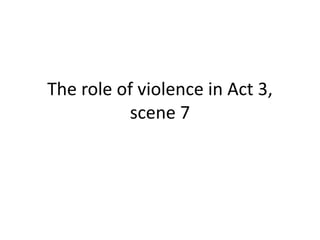
Violence in greek tragedy
- 1. The role of violence in Act 3, scene 7
- 2. Violence in Greek tragedy • Many ancient Greek tragedians employed the ekkyklêma as a theatrical device, which was a platform hidden behind the scene that could be rolled out to display the aftermath of some event which had happened out of sight of the audience. • This event was frequently a brutal murder of some sort, an act of violence which could not be effectively portrayed visually, but an action of which the other characters must see the effects in order for it to have meaning and emotional resonance. • Variations on the ekkyklêma are used in tragedies and other forms to this day, as writers still find it a useful and often powerful device for showing the consequences of extreme human actions.
- 3. Portrayal of violence • There were constraints to portraying violence: – the audience must never witness any act or occurrence that impinged on a human or animal body so as to be the proximate cause of a death – the audience must not witness any person inflicting a blow on any other person. • The first convention was based on religious considerations, and was unbreakable; the second was based on artistic considerations • However, violence could be presented verbally, through ‘messenger‐speeches’ or other forms of narrative, with virtually no limits on the intensity of the horrors described; nor were the dramatists in the least squeamish about presenting on stage the results of violence in the most appalling form—the blinded Oedipus or Polymestor, the dismembered corpse of Pentheus, Aias amidst the animals he has tortured and slaughtered or the agonies that Prometheus is suffering.
- 4. Think! What is genuinely disturbing/acceptable in a live theatrical performance?
- 5. Key question –AO2 How is the violence of this scene is conveyed through language (imagery, figurative language, line length, caesura, punctuation)?
- 6. Key question - AO3 Why might Shakespeare have wanted his audience to endure the blinding of Gloucester?
- 7. Critical starting point... Wilson Knight in the chapter called "King Lear and the Comedy of the Grotesque'' in his book The Wheel of Fire (1930) writes: The gouging out of Gloucester's eyes is a thing unnecessary, crude, disgusting; it is meant to be. It helps to provide an accompanying exaggeration of one element --- that of cruelty --- in the horror that makes Lear's madness. And not only horror: there is even again something satanically comic bedded deep within it. The sight of physical torment, to the uneducated, brings laughter. Shakespeare's England delighted in watching both physical torment and the comic ravings of actual lunacy. These ghoulish horrors, so popular in Elizabethan drama and the very stuff of the Lear of Shakespeare's youth, Titus Andronicus, find an exquisitely appropriate place in the tragedy of Shakespeare's maturity which takes as its especial province the territory of the grotesque and the fantastic which is Lear's madness.
- 8. Summing up • Eyes/ vision are key motifs in the play. – Where else do they occur? – What is the symbolic significance?
